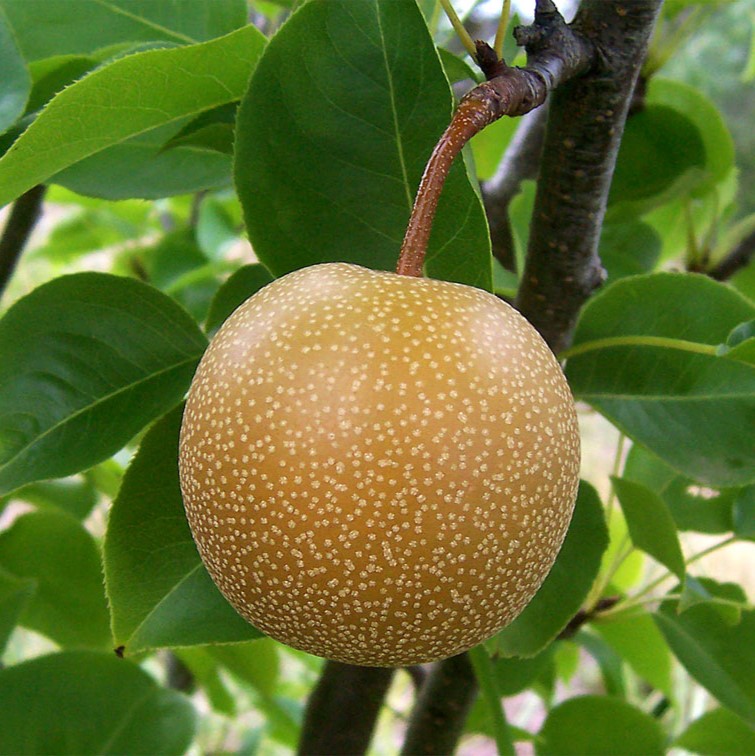Pyrus pyrifolia
Overview
| Genus | Pyrus |
| Species | pyrifolia |
| Common Name | Asian pear, Persian pear, Japanese pear, Chinese pear, Korean pear, Taiwanese pear, apple pear, zodiac pear, three-halves pear, papple, naspati and sand pear. |
| Abbreviation | P. pyrifolia |
| Ploidy | Diploid |
| Chromosome Number | 2n = 34 |
| Genome Size | 540 Mb |
| Genome Assemblies | 2 |
| Cross Reference | NCBI taxon: 3767 |
Organism Image

Description
Pyrus pyrifolia is a species of pear tree native to southern China and northern Indochina, and have been introduced to Korea, Japan and other parts of the world. The tree's edible fruit is known by many names, including Asian pear, Persian pear, Japanese pear, Chinese pear, Korean pear, Taiwanese pear, apple pear, zodiac pear, three-halves pear, papple, naspati and sand pear. Along with cultivars of P. × bretschneideri and P. ussuriensis, the fruit is also called the nashi pear. Cultivars derived from Pyrus pyrifolia are grown throughout East Asia, and in other countries such as India, Pakistan, Nepal, Australia, New Zealand, and the United States. Traditionally in East Asia the tree's flowers are a popular symbol of early spring, and it is a common sight in gardens and the countryside.
The fruits are not generally baked in pies or made into jams because they have a high water content and a crisp, grainy texture, very different from the European varieties. They are commonly served raw and peeled. The fruit tends to be quite large and fragrant, and when carefully wrapped (it has a tendency to bruise because of its juiciness), it can last for several weeks (or more) in a cold, dry place.
S genes
Pyrus pyrifolia PPY_r1.0 S genes
| Query | Chr | Size(bp) | Coordinates | BLASTn Hit | BLASTn %ID | Domain |
| PpySFBB.XVI | PPY_r1.0chr17 | 31990591 | 29400500-29401687 | ON918627.1, PbrSFBB.XVI-S17 | 98.91 | F-box; F_box_assoc |
| PpySFBB.XIV | PPY_r1.0chr17 | 31990591 | 29417387-29418607 | ON918625.1, PbrSFBB.XIV-S17 | 98.85 | F-box; F_box_assoc |
| PpySFBB.XIII | PPY_r1.0chr17 | 31990591 | 29427360-29428541 | ON918624.1, PbrSFBB.XIII-S17 | 99.58 | F-box; F_box_assoc |
| PpySFBB.IX | PPY_r1.0chr17 | 31990591 | 29453987-29452785 | ON918620.1, PbrSFBB.IX-S17 | 97.1 | F-box; F_box_assoc |
| PpySFBB.VI | PPY_r1.0chr17 | 31990591 | 29486571-29485393 | ON918617.1, PbrSFBB.VI-S17 | 98.56 | F-box; F_box_assoc |
| PpySFBB.III | PPY_r1.0chr17 | 31990591 | 29531116-29532297 | ON918615.1, PbrSFBB.III-S17 | 95.99 | F-box; F_box_assoc |
| PpySFBB.II | PPY_r1.0chr17 | 31990591 | 29569337-29570527 | ON918614.1, PbrSFBB.II-S17 | 95.14 | F-box; F_box_assoc |
| PpySFBB.IV | PPY_r1.0chr17 | 31990591 | 29575064-29576248 | ON918616.1, PbrSFBB.IV-S17 | 94.6 | F-box; F_box_assoc |
| PpySFBB.VII | PPY_r1.0chr17 | 31990591 | 29624823-29626001 | ON918618.1, PbrSFBB.VII-S17 | 95.67 | F-box; F_box_assoc |
| PpySFBB.VII.2 | PPY_r1.0chr17 | 31990591 | 29655787-29656965 | ON918618.1, PbrSFBB.VII-S17 | 91.1 | F-box; F_box_assoc |
| PpySFBB.XI | PPY_r1.0chr17 | 31990591 | 29687115-29685931 | ON918622.1, PbrSFBB.XI-S17 | 93.84 | F-box; F_box_assoc |
| PpySFBB.XVIII | PPY_r1.0chr17 | 31990591 | 29733172-29731985 | ON918628.1, PbrSFBB.XVIII-S17 | 87.5 | F-box; F_box_assoc |
| PpySFBB.I | PPY_r1.0chr17 | 31990591 | 29796689-29797891 | ON918613.1, PbrSFBB.I-S17 | 94.02 | F-box; F_box_assoc |
| PpySFBB.X | PPY_r1.0chr17 | 31990591 | 29814701-29813520 | ON918621.1, PbrSFBB.X-S17 | 95.35 | F-box; F_box_assoc |
| PpySFBB.XII | PPY_r1.0chr17 | 31990591 | 29835171-29833999 | ON918623.1, PbrSFBB.XII-S17 | 95.31 | F-box; F_box_assoc |
| PpySFBB.XV | PPY_r1.0chr17 | 31990591 | 29926426-29925194 | ON918626.1, PbrSFBB.XV-S17 | 94.73 | F-box; F_box_assoc |
| PpySFBB.XIX | PPY_r1.0chr17 | 31990591 | 29982617-29981385 | ON918629.1, PbrSFBB.XIX-S17 | 97.08 | F-box; F_box_assoc |
| PpySFBB.VIII | PPY_r1.0chr17 | 31990591 | 30046349-30045159 | ON918619.1, PbrSFBB.VIII-S17 | 98.99 | F-box; F_box_assoc |
| S-RNase | PPY_r1.0chr17 | 31990591 | 29677347-29677592,29678746-29679180 | D49527.1 | 100 | RNase_T2 |
Downloads
The Pyrus pyrifolia S gene sequences are available in FASTA format.
| CDS and Protein (FASTA file) | S-gene_Pyrus_pyrifolia |
Publications
Shirasawa K, Itai A, Isobe S. Chromosome-scale genome assembly of Japanese pear (Pyrus pyrifolia) variety 'Nijisseiki'. DNA Res. 2021 May 2;28(2):dsab001. doi: 10.1093/dnares/dsab001.
Gao Y, Yang Q, Yan X, Wu X, Yang F, Li J, Wei J, Ni J, Ahmad M, Bai S, Teng Y. High-quality genome assembly of 'Cuiguan' pear (Pyrus pyrifolia) as a reference genome for identifying regulatory genes and epigenetic modifications responsible for bud dormancy. Hortic Res. 2021 Sep 1;8(1):197. doi: 10.1038/s41438-021-00632-w.
Sun M, Yao C, Shu Q, He Y, Chen G, Yang G, Xu S, Liu Y, Xue Z, Wu J. Telomere-to-telomere pear (Pyrus pyrifolia) reference genome reveals segmental and whole genome duplication driving genome evolution. Hortic Res. 2023 Oct 12;10(11):uhad201. doi: 10.1093/hr/uhad201.